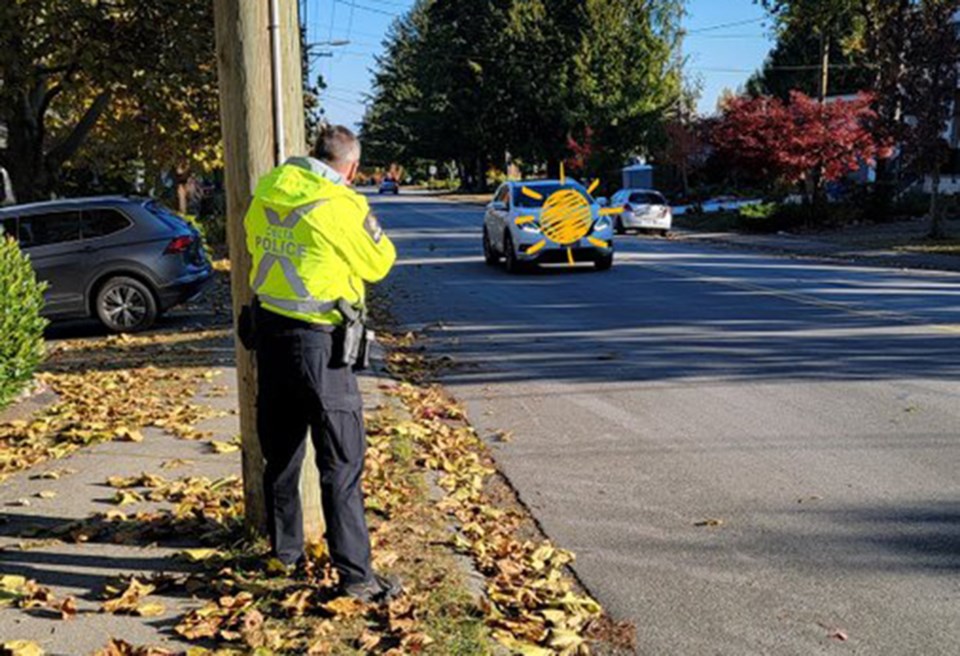Having cops responding to people’s complaints about loud, fast cars, parking peeves and flexible interpretations of what’s a legal stop, doesn’t solve all of the problems.
The Tell Us Where to Go program though has other benefits, such as increasing public awareness and reducing the frustration levels of people concerned about their neighbourhoods.
Delta Police have been offering the Tell Us Where to Go program for three years now. Twice a year, police will put out a notice on social media asking people about their pet peeves regarding traffic.
Complaints will flow in from around the city, covering everything from reckless U-turns, careless parking, tailgaters and drag racers.
Police will then visit those locations, observe and if needed, enforce, and tell the public their view of the situation using Facebook, Twitter and Instagram.
On the most recent Tell Us Where to Go day on Nov. 17, 10 members of the traffic section, along with Speed Watch volunteers, visited 60 locations.
“So far, everyone is obeying the 30 km/h speed zone,” police reported outside Sunshine Hills elementary.
“Not everyone,” responded a resident, who said he sees tailgaters, speedsters and people making U-turns when they shouldn’t. For instance, along 112th Ave., “… drivers are stepping on the gas like it’s a drag strip. You can hear the modified mufflers, screeching of the tires, the revving of the engines …”
Outside Annieville elementary though, “Once again, parents were keeping their speeds down for the kids!” Delta police reported.
And when police set up their radar gun on English Bluff Road in Tsawwassen, drivers were obeying the speed limit, “so far,” reported one officer, while the same was reported for Boundary Bay.
“Boundary Bay – we heard you! But so far everyone is obeying the 60 km/h posted speed,” police said on Facebook.
But that wasn’t all quiet. Police did stop a car for doing 55 km/h in a school zone on 12th Ave. and issued a warning, while they also wrote a ticket for a local resident doing 57 km/h in a 30 km/h zone in the Sunwood Drive area.
However, one resident posted there’s a constant stream of traffic during school time in that area and that at a recent Blockwatch meeting, speeding traffic was the top concern.
“We received a lot of complaints about school zones this year. A reminder that school zones Are in effect from 8 a.m. to 5 p.m.,” police reminded their Facebook followers.
Police also spotted and stopped a car doing 119 km/h on the Alex Fraser Bridge in a 70 km/h zone, while 16th Ave. at 56th St. is another favourite location for Tell Us Where to Go.
The program is a good way to connect with the community, said Acting Insp. James Sandberg.
Using the back and forth of social media, the public can comment while police can give their view when they’re on site, building a communication process.
“We’re trying so much … to get back to our grass roots, which is community policing, which is partnership with our community,” Sandberg said.
“You’ll hear me say it time and again, that we can’t do it alone. We rely on our community to keep our community safe.
“I will say it’s an educational piece as well,” he added.
With a little more expertise than the average Joe, police can give an objective view of a location, and thus allay some concerns.
Sometimes after checking out a complaint area, vehicles simply are not travelling as fast as some residents think and police discover that most motorists are driving within accepted speeds.
He pointed out that officers usually observe an approaching vehicle visually and determine its approximate speed before activating the radar gun.
For him, a key factor is whether the vehicle is being driven in a way that’s a risk to the public.
“If I see something in traffic that I perceive as dangerous, my scrutiny level is going to get focused that much more because of the public safety piece,” he said.
Sandberg said some call the program a waste of time but he disagrees.
“It’s not a waste of resources because it raises awareness. It does some enforcement,” said Sandberg adding that if police connect with one driver and get her or him to drive more safely, it’s worth it.
Some other police forces also seem to like the program.
Road and traffic safety is one of the public’s highest priorities, he added.


